Treatment Options for Failing Conventional Crowns
- Alex Huszti

- Jun 30, 2020
- 3 min read
Updated: Jul 21, 2022

Common Myth: Crowns last forever. Reality: 5–20 Years.
It would be a beautiful fairytale if crowns lasted forever. The harsh reality is that most patients will go through several restorative cycles. If you really want to keep your teeth for life, whoever is caring for your dental needs, must build a massive amount of redundancy into their planning and ongoing care.
What do I mean by redundancy? Apollo 11 – man’s first successful mission to the moon was driven on computing power that equated to a fraction of what is present in a simple digital watch (not even a smartwatch!) You can imagine with the complexity of a mission to the moon; many things can go wrong. As part of the planning, every single step of the program had a back-up system. There wasn’t a step in the program that didn’t have alternative options if the first option failed.
Yet – what is one of the most common concepts thrown at me about crowns: they last forever. This is not a statement that demonstrates planning around redundancy because frankly, nothing lasts forever.
If you can avoid a conventional crown, then avoid it. Avoid any procedure that cuts away tooth structure unnecessarily – particularly tooth structure in the neck of the tooth (the area near the gum that joins the tooth ‘crown’ to the tooth roots). Stick to well-placed conventional fillings that are repairable for as long as possible.
What if I’ve already got a crown (and it is failing)?
OPTION 1: Repair. Sometimes a crown presents with a ceramic fracture – but – the margins of the crown are sealing well, and it is solidly bonded to the tooth. This situation is an opportunity to repair the fractured ceramic with a resin veneer or a resin filling. Doing this is not only more cost-effective than a new crown, but it is also far less traumatic for the underlying tooth and can usually be completed in a single appointment
OPTION 2: Replace the conventional crown with a Composite Resin Crown. Plenty of operators will tell you that you can’t go back from a crown to a filling (this would appear to be some of the attraction of crowns to many dentists). This is not universally true. I have successfully reverted patients from conventional crowns to a composite resin filling (Belledental CRC). Although not universally applicable, if you can, I think you should. The placement of a resin restoration involves a thorough cleaning of the tooth – removal of all decay, and results in a restoration that can be repaired (as opposed to conventional crowns that are largely unrepairable and demand replacement).
OPTION 3: Replace the conventional crown with a new conventional crown. Yes, this will probably work - but you are most likely not to have any more bites of the cherry. Also, it is more expensive than a composite resin crown. The replacement of the conventional crown with a new conventional crown usually results in further cutting of the tooth in the name of getting to ‘fresh’ tooth. This is likely to be the last restoration that the tooth endures.
OPTION 4: Replacing the conventional crown with a strongly bonded temporary crown. This option is one that I recommend in situations where the writing is on the wall for the tooth but – we are not quite ready to lose the tooth yet. I’ll often make a temporary crown (from temporary crown material) and bond this in place with one of the strongest adhesive cements I have. In my practice, I have a number of such crowns in function; patients are comfortable, and if something catastrophic happens, the patient knows the tooth needs to go.
IN SUMMARY – The best option is to be as conservative as possible with your own teeth.

DR ALEX HUSZTI BelleDental
Alex has had a career focused on low-biologic cost reconstructive cosmetic dental care – common sense teeth for life.























































